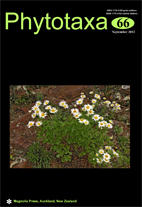Abstract
Myriocolea irrorata is an endemic rheophytic liverwort known from a few localities in the Eastern Andes of Ecuador. Morphologically it belongs to the Cololejeunea-Tuyamaella clade of Lejeuneaceae, however, due to its exclusively Radula-type branching, transversely inserted, hollow leaves, large size, and an extremely high number of clustered gynoecia it has often been regarded as an isolated element of this group. Phylogenetic analyses of a molecular dataset consisting of three markers (nuclear ribosomal ITS region, plastidic trnL-F region and rbcL gene) and 20 accessions resolved Myriocolea in one of the main clades of Colura, sister to the generitype Colura calyptrifolia. Based on the molecular topology and a reinterpretation of morphological traits, Myriocolea irrorata is transferred to Colura, as Colura irrorata. The example Myriocolea/Colura adds to growing evidence that rheophytic liverworts may develop unusual morphologies that hamper their classification using exclusively morphology.

